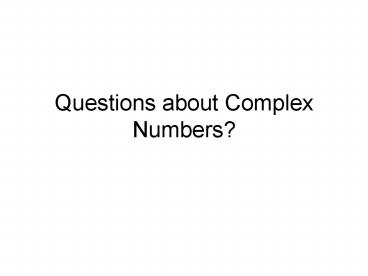Questions about Complex Numbers? PowerPoint PPT Presentation
1 / 23
Title: Questions about Complex Numbers?
1
Questions about Complex Numbers?
2
Fourier Transform and Frequency Response
Is sometimes called the Spectrum of x(t)
This is not the same as the power spectrum of a
random process, but it does describe the
frequency content of a deterministic signal
3
Fourier Transform and Frequency Response
Is a complex-valued function of f, so it
can be written in polar form
or rectangular form
4
Fourier Transform and Frequency Response
Key Point The Frequency Response of an LSI
system is equal to the Fourier transform of the
impulse response.
Note that the Fourier transform is a linear
operator
5
Fourier and Laplace Transforms
A Tale of Two French Mathematicians
It looks as if the Fourier transform is the
Laplace transform, with j2pf substituted for s.
6
Fourier and Laplace Transforms
j2pf
Consider the s plane
s
So, the Fourier transform is the Laplace
transform evaluated only along the j2pf (or jw)
axis as long as the Laplace transform of a
given signal is defined on the j2pf axis.
7
Fourier and Laplace Transforms
I think this has already been pointed out, but
its important The spectrum (Fourier transform)
of the output of an LSI system may be found by
multiplying the spectrum (Fourier transform) of
the input signal by the system frequency response
(Fourier transform of the impulse response).
8
More About Poles and Zeros
Recall from Lecture 1 that the transfer function
of an LSI system can be expressed as the ratio of
two polynomials, which may be factored as
Notice that H(s) goes to zero wherever szi and
goes to infinity wherever spi. These points are
called zeros and poles, respectively
9
More About Poles and Zeros
Weve previously seen that the poles and zeros
may be plotted on the s plane
10
More About Poles and Zeros
The system frequency response is the Laplace
transform evaluated along the imaginary axis of
the s plane. We can do this by drawing vectors
from each of the poles and zeros to the point on
the imaginary axis representing the frequency for
which we wish to find the response.
11
More About Poles and Zeros
The magnitude of the frequency response is the
product of the lengths of the vectors originating
at the zeros, divided by the product of the
lengths of the vectors originating at the poles.
If the real part of a pole is small, the response
will have a dramatic peak at the frequency equal
to the imaginary part of the pole.
12
More About Poles and Zeros
The phase is found by adding the angles of the
zero vectors and subtracting the angles of the
pole vectors.
13
Fourier Transform Convolution
Recall that the time-domain response of a system
to an arbitrary input signal is found by
convolving the input with the impulse response
Recall further that the frequency response is
Since
We have a transform pair
14
Fourier Transform Convolution
In other words, convolution in the time domain is
equivalent to multiplication in the frequency
domain.
We can also perform convolution in the frequency
domain
Well, guess what? Frequency domain convolution
is equivalent to time domain multiplication!
15
Time and Frequency Shifting.
Suppose we have a signal, x(t)
y(t)
t
0
And its Fourier transform
16
Time and Frequency Shifting.
If we shift the signal to the right by an amount
t0 (delay it by t0)
t
17
Time and Frequency Shifting.
The magnitude of the Fourier transform isnt
changed, since
The delay t0 is equivalent to a phase shift of
18
Time and Frequency Shifting.
Suppose instead of shifting x(t) in time, we
shift Xa(f) in frequency by an amount f0
Xa(f)
f
f0
0
-f0
19
Time and Frequency Shifting.
So, we can shift the signal x(t) in frequency by
multiplying it with a complex exponential. Very
useful this is called radio! Wheres that
complex exponential generator?
Well, well just have to settle for a sinusoid.
20
Time and Frequency Shifting.
Xa(f)
f
0
f0
-f0
This is the same thing as double sideband AM
modulation (suppressed carrier), and f0 is the
carrier frequency
21
Symmetry
The Fourier transform has some symmetry
properties which can make life easier. If x(t)
is real, the real part of its Fourier transform
has even symmetry and the imaginary part has odd
symmetry
The amplitude spectrum has even symmetry, and the
phase spectrum has odd symmetry
22
Symmetry
If x(t) is even, meaning x(t) x(-t), then Xa(f)
is real. If x(t) is odd, then Xa(f) is
imaginary.
23
Problems

